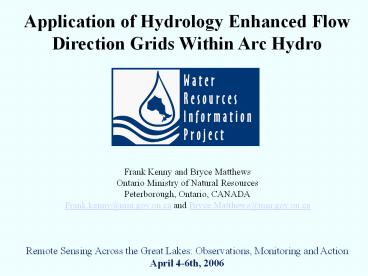Application of Hydrology Enhanced Flow Direction Grids Within Arc Hydro - PowerPoint PPT Presentation
1 / 23
Title:
Application of Hydrology Enhanced Flow Direction Grids Within Arc Hydro
Description:
Application of Hydrology Enhanced Flow Direction Grids Within Arc Hydro ... 3 major rounds of Training Completed Dr. Dean Djokic ... – PowerPoint PPT presentation
Number of Views:95
Avg rating:3.0/5.0
Title: Application of Hydrology Enhanced Flow Direction Grids Within Arc Hydro
1
Application of Hydrology Enhanced Flow Direction
Grids Within Arc Hydro
Frank Kenny and Bryce Matthews Ontario Ministry
of Natural Resources Peterborough, Ontario,
CANADA Frank.kenny_at_mnr.gov.on.ca and
Bryce.Matthews_at_mnr.gov.on.ca
Remote Sensing Across the Great Lakes
Observations, Monitoring and Action April 4-6th,
2006
2
ONTARIO, CANADA
Peterborough
3
Presentation Overview
- Provincial Watershed Project where we are in
Ontario/where we are going - Commonly encountered problems in raster
hydrology - Strategies for optimizing the Raster environment
for hydrology - Developing Enhanced flow direction grids
- Application Example Accommodating Tile Drain
fields with Enhanced flow direction grids.
4
Where we are in Ontario
Seamless Covers Hydrology Network - The Arc
Hydro Backbone Provincial Digital
Elevation Model
- Over 10,000, 110/20 K scale Photogrammetrically
derived topographic maps have been seamlessly
merged. - Network Geometry has been developed for the
province (to approx.. 52 deg) - Every Ontario stream QA/QC by local Conservation
Authorities and MNR district. - Version I completed (2000) Utilizing ANUDEM
- Version II just completed (2006) Includes the
integration of lake elevation and DTM data.
5
Removing Systematic Artefacts from the Digital
Elevation Model
DTM Filtering
OBM with Stripe Artefact
6
Where we are at (part II)
Arc Hydro Provincial Flow Direction Grid
- 3 major rounds of Training Completed Dr. Dean
Djokic - Implementation in seven major northern Ontario
Watersheds. - Being adopted across 30 southern Ontario
Watershed Based Conservation Authorities - Methodology refined and finished
- Developed and loaded into the Land Information
Ontario - Warehouse
7
Commonly Encountered Problems in Raster Hydrology
- Application of a uniform cutoff value to
accurately reflect known hydrology. - Limitations of the DEM source data to accurately
depict hydrology patterns.
8
100 Pixel Flow Accumulation Overlain the 150K
Hydrology
Notice alignment is generally good - although one
major watershed error is evident (denoted )
9
STREAMLINE FUNCTION AT VARIOUS FLOW ACCUMULATION
CUT-OFFS
150K NTS HYDROLOGY 200 PIXEL DRAINAGE
100 PIXEL DRAINAGE 50
PIXEL DRAINAGE
10
Strategies for Optimizing the Raster Environment
for Hydrology
- Inclusion of a flow directed hydrology network as
a boundary condition during DEM interpolation.
To encode known flow directions in decreasing
elevations. (e.g. ANUDEM, TOPOGRID). - DEM modifications, post creation using a
drainage network to ensure focused flow along and
down known water courses. (eg. Stream Burning,
AGREE) - 3. Redeveloping the Flow Direction Grid to
include the Topological information Content of
the hydrology network and water bodies. (The
proposed method this Presentation)
11
Steps to Developing an Enhanced Flow Direction
Grid
- Three Primary Inputs
- 1. Standard Approach to deriving flow
directions (eg. FLOWDIRECTION) - A hybridized raster/vector topological analysis
to assigning D8 flow directions to cells that
intersect the network. - An iterative raster single cell dilation and D8
assignment from within water bodies to focus flow
towards the virtual segments. - 4. A merging of results from steps 1, 2 and 3
to produce a final enhanced flow direction
grid.
12
Catchment, DrainagePoint and DrainageLine
The Catchment, DrainagePoint and
DrainageLine feature classes in Arc Hydro store
the vector products resulting from terrain
analysis using a Digital Elevation Model.
13
Automated Catchment, DrainageLine and
DrainagePoint Generation in Arc Hydro
14
Scales of representation of Drainage Systems
Basins drainage areas for water resources
management
Watersheds subdivision of Basin for a
particular hydrologic purpose
Catchments subdivision of Basin into elementary
drainage areas by physical rules
Digital Elevation Model land surface terrain
grid cells
15
Arc Hydro Drainage (raster) and Arc Hydro
Hydrography (vector) (continued)
This is actually two separate problems appearing
as one 1) Gross alignment errors between the
raster flow direction grid and the vector
photogrammetrically interpreted hydrography 2)
A DrainageLine density issue associated with
applying a uniform flow accumulation cut-off
value. Within WRIP we believe we have in a very
efficient manner solved both.
16
Example of a Junction within a Wetland
TIN to Grid ANUDEM
Stream Burning Enhanced Flow Direction
A)
B)
100 m.
C)
D)
17
Example of On-Network Lakes and Stream Junctions
within a Wetland
TIN to Grid ANUDEM
Stream Burning Enhanced Flow
Direction
A)
B)
100 m.
D)
C)
18
A Single Meandering Stream
TIN to Grid ANUDEM Steam
Burning Enhanced Flow
Direction
A)
B)
100 m.
C)
D)
2
1
19
Full Arc Hydro partitioned catchments using the
photo-interpreted stream network, and an
Enhanced, Flow Direction grid. Note, each
hydrographic reach has one and only one
catchment.
20
Accommodating Tile Drain Fields with Enhanced
Flow Direction Grids.
Natural Drainage
21
(No Transcript)
22
Hydro Networks The hydro network is the
backbone of Arc Hydro, created from edges and
junctions. The topological connection of its
HydroEdges and HydroJunctions in a geometric
network enables tracing of water movements
upstream and through streams, rivers, and water
bodies Relationships built from the
HydroJunctions connect drainage areas and point
features such as stream gage stations to the
hydro network. Locations on the hydro network
are defined by a river-addressing scheme that
defines where points are located on lines within
drainage areas, allowing measurements of flow
distance between any two points on a flow path.
23
Scales of representation of Drainage Systems
Basins drainage areas for water resources
management
Watersheds subdivision of Basin for a
particular hydrologic purpose
Catchments subdivision of Basin into elementary
drainage areas by physical rules
Digital Elevation Model land surface terrain
grid cells

